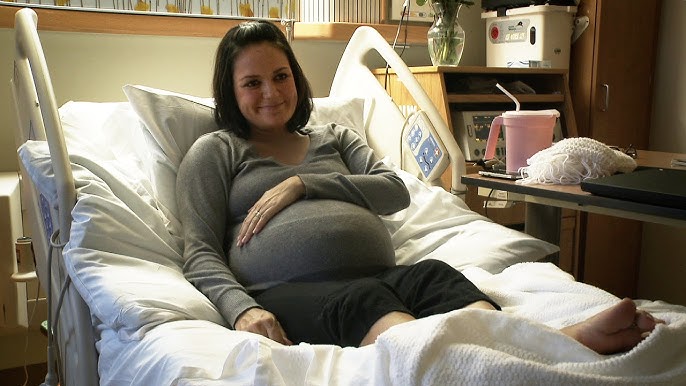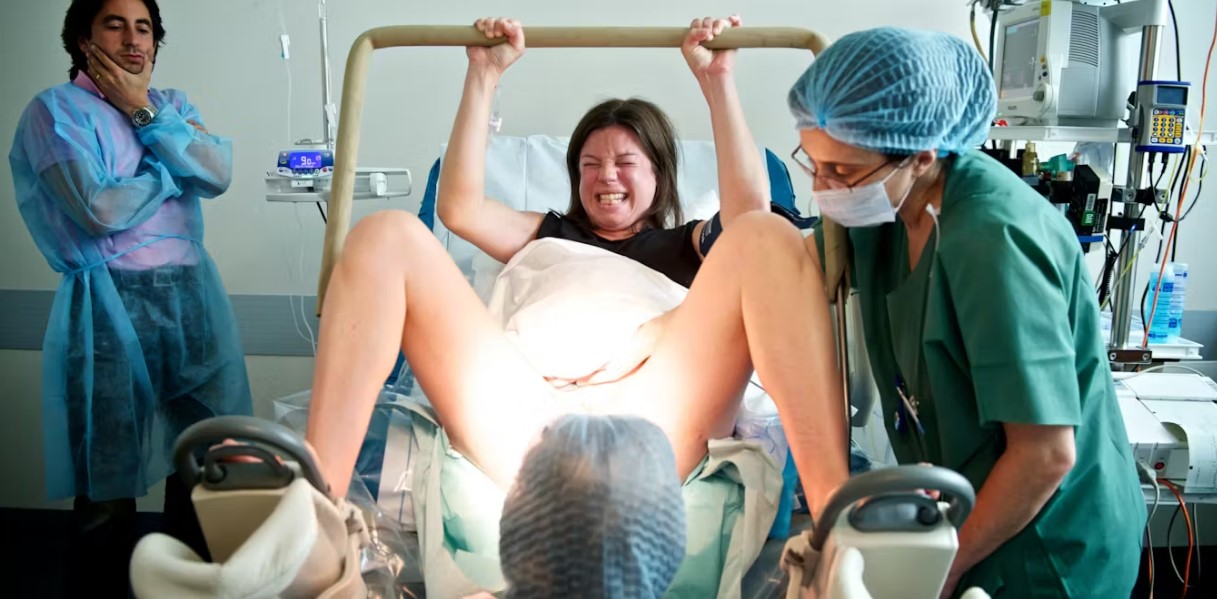Bringing a new life into the world is a remarkable journey – one that unfolds uniquely for every expectant mother. In this profound chapter of womanhood, the process of childbirth transcends mere physicality; it’s an experience brimming with emotions, anticipation, and pivotal decision-making.
Among the various choices expectant mothers face during labor, the selection of birthing positions stands as a crucial yet often overlooked aspect. Labor positions are more than mere posture; they can significantly impact the ease, progress, and comfort of childbirth.
As we delve into the vast repertoire of labor positions, one particular stance, the knee-to-chest position, emerges as a compelling choice for many women. In this guide, we’ll uncover the intricacies of this position, unraveling its benefits, the ideal scenarios for its application, and the empowering stories that underscore its efficacy.
Childbirth isn’t a one-size-fits-all journey. Each woman embraces her unique rhythm, challenges, and aspirations for her birthing experience. Recognizing this, the knee-to-chest position offers an alternative, inviting mothers to explore a posture that might resonate with their bodies and the needs of their growing baby.
Recommended: How To Get Rid Of Smelly Discharge During Pregnancy
Moreover, the significance of selecting a suitable labor position extends beyond physical comfort; it fosters a sense of agency and control amidst a transformative moment. By understanding the nuances of positions like the knee-to-chest posture, mothers and their support systems can actively participate in optimizing the birthing process, aligning it more closely with their desires and needs.
- What is the Knee-to-Chest Position?
- Benefits of the Knee-to-Chest Position
- Disadvantages of knee to Chest position
- When to Consider Using the Knee-to-Chest Position
- When Not to Use the Knee To Chest Position In Labor
- How to Achieve the Knee-to-Chest Position
- Precautions and Considerations
- Alternatives and Complementary Positions
- FAQs
- Conclusion
What is the Knee-to-Chest Position?
Amidst the array of labor positions, the knee-to-chest position stands distinct in its simplicity and effectiveness. This position involves the mother-to-be lying on her back, gently drawing her knees toward her chest and holding them in position, allowing her pelvis to tilt and open.
The key characteristic of the knee-to-chest position lies in its ability to create a spacious and favorable alignment within the pelvic region. By bringing the knees closer to the chest, the pelvic outlet widens, offering more room for the baby’s descent through the birth canal.
Recommended: Can You Drink Gatorade While Pregnant?
Unlike conventional reclined positions, such as lying flat on the back, the knee-to-chest stance provides a different angle for labor progression. It capitalizes on gravity while maintaining the mother’s comfort, allowing her to take an active role in facilitating the birthing process.
This position often provides relief to women experiencing back labor or discomfort associated with the pressure of the baby’s head on the perineum. By adjusting the angle of the pelvis and encouraging a better alignment of the baby’s head, it can alleviate some of the strain and pressure, potentially leading to a smoother labor experience.
Recommended: Does Family Planning Affect Future Pregnancy?
The knee-to-chest position isn’t merely a physical posture; it embodies an approach that honors the natural mechanics of childbirth. It empowers the mother to engage with her body’s intuitive movements, fostering a sense of connection and agency during this profound journey of bringing new life into the world.

Furthermore, while the knee-to-chest position holds universal relevance in childbirth, its historical and cultural significance across different societies underscores its time-honored place in the spectrum of birthing practices. From traditional midwifery to contemporary obstetrics, this position’s adaptability and effectiveness echo through diverse cultural narratives, affirming its enduring value in childbirth.
Recommended: Does Ovulation Make You Emotional?
In essence, the knee-to-chest position serves as a bridge between tradition and modernity, embracing the wisdom of time-tested birthing practices while integrating seamlessly into contemporary approaches to childbirth.
Benefits of the Knee-to-Chest Position
The knee-to-chest position during labor encompasses a multitude of advantages, catering to both the mother and the baby’s well-being, fostering an environment conducive to a smoother birthing experience.
1. Facilitation of Pelvic Opening
The knee-to-chest position offers a strategic alignment of the pelvic bones, allowing the baby’s head to descend optimally through the birth canal. This alignment aids in creating a wider passage, reducing potential obstructions that might impede the baby’s progress.
By adjusting the pelvic tilt in this position, there’s a notable reduction in pressure on the perineum. This relief can be particularly beneficial during the latter stages of labor, minimizing discomfort and potentially lowering the risk of perineal tearing.
Recommended: Top 4 Signs That a Man Has Not Been Sexually Active
2. Increased Uterine Contractions and Efficiency
The angle created by the knee-to-chest position encourages the baby’s descent. This posture can assist in harnessing the power of gravity, aiding the baby’s journey down the birth canal and potentially expediting labor progress.
Studies suggest that this position may contribute to more efficient contractions, enhancing the overall effectiveness of uterine contractions and potentially shortening the duration of labor.
3. Improved Fetal Positioning
The knee-to-chest position encourages an optimal fetal position for birth. By aligning the baby’s head with the pelvic opening, it assists in achieving an ideal positioning for a smoother and more straightforward delivery.
This improved fetal positioning may potentially reduce the likelihood of complications during childbirth, such as fetal malpositioning or prolonged labor due to unfavorable positioning.
Recommended: 10 Best Vitamins For Hormonal Acne
The beauty of the knee-to-chest position lies in its ability to merge comfort with effectiveness. It offers mothers a position that not only alleviates discomfort but actively contributes to the progression of labor. This empowerment through comfort and efficacy serves as a testament to the versatility and benefits of this birthing posture.
Disadvantages of knee to Chest position
While the knee-to-chest position can offer benefits during labor for many women, there are potential disadvantages or considerations to keep in mind:
1. Limited Mobility
Maintaining the knee to chest position for an extended period might limit the mother’s ability to change positions frequently during labor, which is often recommended for comfort and labor progression.
2. Discomfort for Some Women
While this position can alleviate pain for many, for some women, it might not offer the expected relief or could even intensify discomfort, particularly if they have certain musculoskeletal issues or find the position physically straining.
3. Incompatibility with Certain Conditions
In specific medical scenarios, such as complications related to the baby’s position or umbilical cord concerns, healthcare providers may advise against assuming the knee to chest position.
Recommended: Does Blue Cross Blue Shield Cover Testosterone Treatment?
4. Limited Adaptability:
While versatile, the knee to chest position might not be ideal for every stage of labor. It might be more beneficial during certain phases (like pushing) and less effective or comfortable during others.
5. Potential for Fetal Distress
In some cases, the pressure applied to the abdomen in the knee to chest position might not be well-tolerated by the baby, potentially causing fetal distress.
6. Lack of Comfort or Effectiveness
Every woman’s experience of labor is unique. What works well for one might not necessarily be comfortable or effective for another. Some women might find this position challenging or less beneficial.
7. Medical History and Conditions
Women with certain pre-existing medical conditions or histories might find the knee to chest position less suitable due to how it affects their comfort or health during labor.
8. Dependence on Healthcare Guidance
Correctly assuming the knee to chest position requires guidance. Without proper instructions or support from healthcare providers, its benefits might not be fully realized or could lead to discomfort.
Recommended: Can I Take Magnesium While Breastfeeding?
Understanding these potential disadvantages helps in evaluating whether the knee to chest position is suitable and comfortable for an individual during labor. It’s crucial to discuss birthing positions with healthcare providers to determine the best approach tailored to the specific circumstances of each laboring woman.

When to Consider Using the Knee-to-Chest Position
The knee-to-chest position in labor presents itself as a versatile option, adaptable to various stages and scenarios during childbirth. Understanding when to integrate this position can optimize its efficacy and offer maximum benefits to expectant mothers.
The knee to chest position in labor can be beneficial in various situations during childbirth. Here are scenarios when this position might be particularly useful:
1. Optimal Fetal Positioning
If the baby is in a posterior position (head down but facing the mother’s abdomen), the knee to chest position can help encourage the baby to rotate into a more favorable position for delivery.
2. Labor Progression Challenges
When labor stalls or slows down, assuming the knee to chest position might aid in repositioning the baby for better descent through the birth canal, potentially promoting labor progression.
3. Comfort During Contractions
For mothers experiencing intense back labor or discomfort during contractions, this position can offer relief by opening up the pelvic area and potentially reducing pressure on the back.
4. Assisting with Pushing
During the pushing phase, adopting the knee to chest position can provide leverage and support, allowing the mother to push more effectively while utilizing gravity.
5. Facilitating Labor with Epidural
In situations where the mother has an epidural and is limited in mobility, the knee to chest position may offer an alternative to lying flat on the back, potentially aiding in labor progression despite reduced sensation and movement.
6. Adaptability and Flexibility
The knee to chest position is versatile and can be attempted at various stages of labor to see if it brings comfort and aids in the birthing process. It’s adaptable and can be adjusted to suit the mother’s comfort.
Always consult with healthcare providers or a birthing professional to determine the best positions and strategies tailored to individual circumstances during labor. They can provide guidance based on the specific needs and conditions of both the mother and the baby.
When Not to Use the Knee To Chest Position In Labor
The knee to chest position in labor is generally beneficial, but there are situations where it might not be recommended or suitable:
1. Complications or Medical Advisories
If there are specific complications during labor, such as issues with the umbilical cord, placenta previa, or other conditions affecting the baby’s positioning, healthcare providers may advise against using this position.
2. Unstable Maternal Position
If the mother is unable to maintain balance or stability in the knee to chest position due to weakness, dizziness, or other health concerns, an alternative position may be recommended.
3. Discomfort or Pain Intensification
For some women, the knee to chest position might exacerbate discomfort or pain rather than alleviate it, especially if there are existing back problems or other conditions that worsen with this posture.
4. Unsuitable Fetal Position
In certain cases where the baby is in a specific position that doesn’t align well with the knee to chest posture or might worsen their position for delivery, healthcare providers might suggest avoiding this stance.
5. Individual Preferences and Comfort
Every woman experiences labor differently. If the knee to chest position doesn’t feel comfortable or doesn’t provide relief during contractions, it might not be the best option for that particular individual.
6. Medical Advisories or Contradictions
If healthcare providers have advised against certain positions due to the mother’s medical history, complications, or specific conditions, it’s crucial to follow their guidance and avoid the knee to chest position if they recommend against it.
Ultimately, the decision to use or avoid the knee to chest position should be made in consultation with healthcare professionals, who can evaluate the individual circumstances and determine the best approach for labor.

How to Achieve the Knee-to-Chest Position
Mastering the knee-to-chest position during labor involves a simple yet purposeful maneuver that can be comfortably adopted by expectant mothers with proper guidance and support. Here is a guide on how to achieve a good knee to chest position.
1. Finding a Comfortable Surface
Begin by selecting a supportive surface, such as a mattress or a padded birthing bed. Ensuring comfort and stability is paramount for embracing this position effectively.
2. Initial Positioning
Start by lying on your back, finding a relaxed and comfortable position. This serves as the foundational posture before transitioning into the knee-to-chest stance.
3. Knee Elevation
With a slow and deliberate movement, bring one knee towards your chest. Using your hands or enlisting the support of a birthing partner, guide the knee towards your chest in a smooth motion.
Subsequently, repeat the same movement with the other knee, gradually drawing it towards your chest. Maintain a gentle and controlled pace to ensure comfort and stability.
4. Finding the Ideal Angle
Once both knees are drawn towards your chest, find the angle that feels most comfortable and supportive. This might involve slight adjustments to the positioning of your legs to achieve an optimal posture.
5. Maintaining Stability and Relaxation
You may choose to support your knees in this position by interlacing your arms behind your thighs or seeking assistance from your birthing partner to maintain stability.
Emphasize relaxation in this posture. Allow your body to adapt to the position, taking slow, deep breaths to encourage relaxation and ease any tension.
Involvement of Birth Partners or Support Persons
The role of birth partners or support persons is crucial in assisting mothers in achieving and maintaining the knee-to-chest position. Their encouragement, guidance, and physical support can significantly enhance the comfort and effectiveness of this stance.
The knee-to-chest position embodies a straightforward yet impactful posture during labor. Mastering this position involves a gradual and deliberate approach, ensuring comfort, stability, and the active involvement of birth partners or support persons.
Precautions and Considerations
1. Maternal Comfort and Physical Capability
Not all mothers may find the knee to chest position comfortable or physically feasible during labor. Considerations should be made for women with certain physical limitations, such as joint pain, injuries, or conditions that might restrict movement or flexibility.
2. Baby’s Position and Presentation
In specific cases of fetal malposition or certain complications, healthcare providers might advise against or suggest modifications to the knee to chest position. Consultation with a healthcare professional is crucial to ensure the baby’s safety and optimal positioning during labor.
3. Risk of Hypotension
Adopting certain positions, including knee to chest, might potentially induce hypotension (low blood pressure) in some individuals. Healthcare providers should monitor maternal blood pressure and advise accordingly to prevent any adverse effects.
4. Individual Health Conditions
Women with certain health conditions or complications, such as placental abnormalities or certain cardiac conditions, might not be suitable candidates for the knee to chest position. It’s essential for expectant mothers to discuss their medical history with healthcare providers to evaluate the appropriateness of this birthing position.
5. Labor Progress and Stage
The suitability of the knee to chest position can vary based on the stage and progress of labor. It might be more beneficial during specific stages (such as the pushing phase) or less comfortable during early labor, depending on the individual’s preferences and circumstances.
6. Partner or Support Availability
Women choosing the knee to chest position may require additional support from a birthing partner, doula, or healthcare provider. Ensuring adequate support and assistance in adopting and maintaining this position is crucial for safety and comfort.
7. Medical Guidance and Professional Support
Ultimately, the decision to adopt any birthing position, including knee to chest, should be made in consultation with healthcare providers. Seeking guidance ensures that individual circumstances, risks, and preferences are considered to make an informed decision regarding birthing positions.
8. Alternate Positioning Options
If the knee to chest position isn’t feasible or recommended, explore other birthing positions that offer similar benefits, such as squatting, side-lying, or hands-and-knees positions.
9. Continuous Assessment and Flexibility
Labor is dynamic, and preferences or the suitability of positions can change. Continuous assessment and flexibility in trying different positions based on the labor progress and comfort levels are essential.

Alternatives and Complementary Positions
While the knee-to-chest position offers significant benefits during labor, the birthing journey is diverse and adaptable, encouraging exploration of various positions that complement and enhance the childbirth experience.
1. Upright Positions
Standing or Leaning
Upright positions, such as standing or leaning forward on a support surface, harness gravity to aid in the descent of the baby. These positions often provide comfort and encourage pelvic movement, potentially facilitating a smoother labor progression.
Sitting or Squatting
Sitting or squatting positions during labor can widen the pelvic outlet and optimize the birth canal’s alignment. They offer a natural extension to the knee-to-chest position, empowering mothers to explore stances that resonate with their comfort and instinctive movements.
2. Side-Lying Positions
Lying on one side, commonly referred to as lateral positions, can offer relief and variation during labor. This posture promotes comfort while also encouraging optimal fetal positioning, complementing the benefits of the knee-to-chest position.
3. Hands-and-Knees Position
The hands-and-knees position involves being on all fours, which can alleviate back pain and encourage better fetal positioning. This stance provides a different angle for the baby’s descent and offers comfort to mothers experiencing discomfort during labor.
The beauty of childbirth lies in its adaptability and the myriad possibilities it presents. Exploring different positions, including alternatives and complementary stances to the knee-to-chest position, empowers women to embrace the posture that aligns best with their bodies, preferences, and comfort during labor.
FAQs
What is the knee to chest position in labor?
The knee to chest position involves lying on your back and bringing your knees toward your chest, allowing the legs to bend at the hips and the knees to come close to or touch the chest. This posture opens up the pelvic area and can assist during labor by providing comfort and potentially aiding in the birthing process.
When should I consider using the knee to chest position during labor?
The knee to chest position can be beneficial during labor in various scenarios, such as when experiencing back labor, when there are challenges with the baby’s positioning, or during the pushing stage to aid in effective pushing.
How does the knee to chest position help during labor?
This position can assist by opening up the pelvic area, potentially relieving discomfort during contractions, aiding in optimal fetal positioning for delivery, and providing leverage during the pushing phase.
Can everyone use the knee to chest position during labor?
While many women find this position helpful, it might not be suitable for everyone. Certain medical conditions or complications might contraindicate its use, so it’s essential to consult healthcare providers for personalized guidance.
Is the knee to chest position safe for the baby during labor?
When performed correctly and under professional guidance, the knee to chest position is generally considered safe for both the mother and the baby. However, in specific medical situations, healthcare providers may recommend against this position.
Can the knee to chest position shorten the duration of labor?
It’s possible that the knee to chest position might aid in labor progression for some women by assisting with optimal fetal positioning and effective pushing, potentially reducing the duration of labor.
What if I find the knee to chest position uncomfortable during labor?
Not all positions work for everyone. If you find this position uncomfortable or it doesn’t provide the expected relief, there are various alternative birthing positions available. Discussing options with healthcare providers can help find a more suitable position for you.
How long should I stay in the knee to chest position during labor?
The duration can vary. It’s generally advised to move around and change positions periodically during labor to avoid discomfort or potential complications from staying in one position for too long.
Can partners or support persons assist in achieving the knee to chest position?
Yes, partners or support persons can assist in helping the mother achieve and maintain the knee to chest position by providing physical support, guidance, and encouragement.
Are there any situations where the knee to chest position should be avoided?
Yes, there are instances, such as specific medical contraindications, concerns about the baby’s position, or if the position exacerbates discomfort or pain for the mother, where healthcare providers might advise against using the knee to chest position.
Conclusion
The knee-to-chest position stands as a versatile ally in childbirth, offering comfort and aiding labor progression. Embracing a range of positions, tailored to individual needs, enriches the birthing journey. With expert insights and diverse experiences, mothers are empowered to navigate labor confidently, fostering a sense of connection, comfort, and empowerment throughout this profound and transformative experience.
